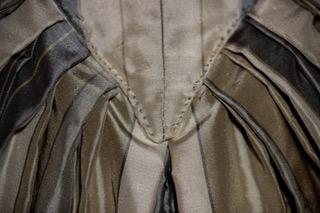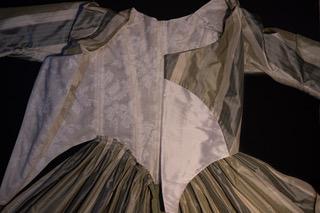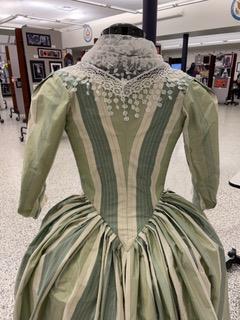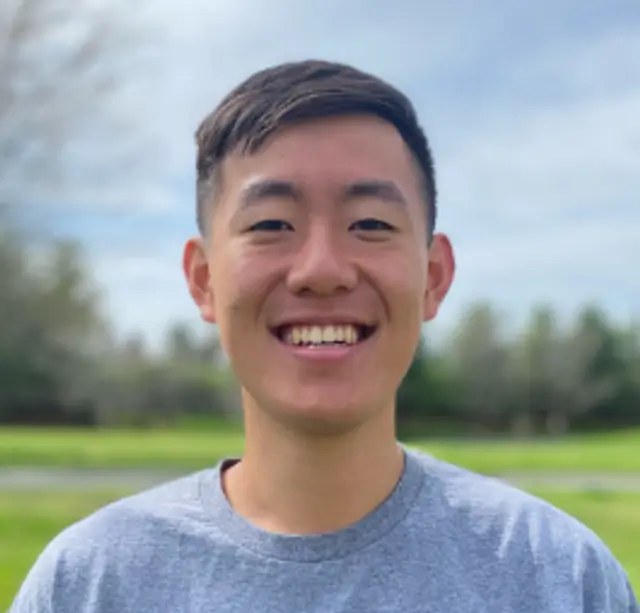Lydia Olivieri’s Passion for Fashion History and Recreating an 18th Century Dress
12 minute read
Lydia Olivieri is a rising high school senior interested in fashion history and sewing. In this conversation with Howard Hsu, Lydia talks about all the hard work she put into her unique project with Polygence, the support she received from her Polygence mentor, and her unconventional advice to students interested in doing an independent project.
Get To Know Lydia
What’s your background?
My name is Lydia, and I am a rising senior from New Jersey but I'm originally from New York. I go to a public vocational school called Communications High School. It focuses on learning how to use media, like journalism, TV, and graphic design.
Lydia’s Experience with Polygence
What did you hope to get out of your Polygence project?
Well, my project was about fashion history and it's something that I've always been really in tune with, and a part of my creative side that I've always really wanted to honor in a sense. I've actually had the idea for my project for literally years, so what I saw was a way for me to do something that I had sort of always set out to do but with a little bit more support along the way, because it was such a big step up from the projects I was pursuing previously.
Can you trace back to where that inspiration came from for your project?
Yeah, I don't have an exact moment where I was like, “this is absolutely like my favorite thing in the world,”, but I have a set of smaller moments. I think the first one was finding out that the American Girls dolls and books existed. I started reading them when I was probably 5 years old, and I was so intrigued by the illustrations on all the dolls and their clothes. In the back of the books, they also provide historical context about fashion - what types of things the characters were wearing and I was always so curious as to why they were wearing certain clothes. My specific love for the eighteenth century came when I was about 8 years old, and I went to Colonial Williamsburg. I got a little book about what little kids did back in that time and one of the pages was about fashion. I remember I would always open it and read it over and over again. I actually started making clothing for my dolls, with pillowcases or T-shirts that had holes in them, or popsicle sticks and whatever I could get my hands on.
Do you remember how you first learned about Polygence?
I had been talking to somebody about wanting to do this project, and they suggested that Polygence was a program that they had heard other kids my age were doing. As I looked at the website, there were filters where you could see the types of projects that people were doing. I was looking at fashion and art and looking at the mentors, and I felt like this was definitely something I could see myself growing in.
What was your Polygence project?
My project in its entirety was to recreate a eighteenth century robe à l'anglaise and so my process for that was I started with a painting. I had been looking at a lot of paintings for historical reference, and if you look back at these paintings they're still as pristine as they were when they were painted and you get all the details of a garment that you wouldn't have on a surviving garment today.
I found a painting actually from the Met titled “Self Portrait with a Harp,” by Rose Adélaïde Ducreux. So in this painting there was a woman artist and a woman subject, and I thought the painting was just so beautiful. I started looking at that painting, and the next step was to find resources for me to construct a dress that was similar in style, time period, location, and demographic. With the help of my mentor, I was able to source a pattern that was based on a garment from the 1780s or late 1770s potentially. I was able to take and alter this pattern so that it fit the exact shape of the dress, and I also used historically accurate material called taffeta, which is what the dress would’ve most likely been made of.
The one historical liberty that I took is that I used my sewing machine for most of it, because that felt like it was worth it for practicality. But I essentially took the project from the ground up. A big part of the project was researching, and then a big part of it was trial and error in terms of actually constructing the garment.
How much time did it actually take to construct the garment?
So actually looking back at it I've been asked this question so many more times than I had anticipated, and I really wish that I logged it and timed it meticulously. But, if I had to guess, maybe say around 150 hours.
That’s incredible! Where is the dress now?
It’s at my house stored in a little garment bag. It's zipped up, but I actually was able to bring it to my school for my art show! I had photos of it taken by my friend who's a photographer, so I have about 30-35 professionally shot, detailed pictures of this dress, which is really exciting.


photos by: Quinn Bender
Was this dress intended to fit you and for you to wear?
There's probably a more detailed answer to this than a lot of people would expect. But a big part of the process for the dress is the fit. The pattern on the dress fit on somebody else's body 250 years ago, and this is during a time when clothing was so valuable, so expensive, and so time consuming that every garment was made to the individual. And so a big part of the dress making process was that the garment had to be fit on the wearer of the dress multiple times. In my situation, I was both the client and the seamstress, which was much more difficult than I anticipated. But it was actually a challenge that I really welcomed. So yes, I can wear it!

Is historical fashion something that you’re still interested in pursuing?
Yeah, definitely, I think the dress is more than just a physical product to me, because
to me it’s a way to study humanity. For example, the amount of silk that has to go into it identifies how rich the French were during the pre-revolutionary period, and the non-human looking shape of the dress can identify things in our history during the French period. During the French Revolutionary period, artificiality was valued over humanity because humans had believed that they had come so far that they didn't need to look like humans anymore. Dresses could have these crazy shapes and colors because, to them, they had no need to look like humans.
So, this is a way for me to learn about humanity and people of the past, and how I feel like they keep their stories alive. For me, sewing and fashion is a way that I pour out my creative energy, but it’s also something that's really academic and the two sort of come together. I am absolutely still interested in continuing down this path.
Mentorship at Polygence
Who was your mentor for your project, and what do you think made them a good fit?
I actually found Desira by looking at the website and seeing the projects she had done with past students that were featured on the website. Once I got matched with her, she had a little bio that I read, and essentially it boiled down to using fashion in the study of people, which is exactly what I wanted. It was really fascinating to see somebody who was so similar to me as a person, but is actually in a bit of a different spot in the industry than I would see myself being in. She's making costumes for movies and for stage productions, and I was able to get in contact with her costume design professor at NYU, who is working in costume shops for Broadway shows. We have very different products but we're essentially practicing the same thing.
I was able to get her wisdom on what her job looked like with her day to day, but I also had someone who really deeply understands sewing and fashion history. There were definitely some points where I was worried that my technical abilities wouldn't necessarily match up to the craft that I was trying to achieve, but during those moments she was able to guide me. She also was able to teach me a lot more about fashion and sewing terminology, because when I was holding a garment in my hand and showing her virtually, I had some trouble describing my issue over our calls. That’s something that will really serve me well for the rest of my journey, and it was particularly helpful for this project since my mentor couldn’t just edit my work. I had to take her recommendations and edit a physical product that she couldn’t see up close.
What was a typical session like between you and your mentor?
Our first 3 meetings were dedicated to the planning stages of this project, because what I think a lot of people don't understand about sewing is you're not just getting fabric and sewing it. There's so much more that happens in between the two processes, and I spent a lot of hours reading, looking for patterns, and drafting smaller versions of it in cheap fabric.
We had a session or two in the beginning to talk about where I wanted to go with the painting, and once we decided on a painting we were identifying the key elements of the dress.
After that, there's a mock up stage where I essentially created a quarter scale version of the dress. That was a really good part of the process, and there were a few troubleshooting moments where we had to spend half a session, or almost a whole session on “where do we go from here?”
After the first few sessions I had long periods to just sew between sessions, and I would just sew until I no longer felt like I was at a crossroads and would ask my mentor for her opinion, and this continued to about the ninth session. For our 10th session, we reflected on everything that I had learned, and we started talking about the best way to present my project.
Takeaways from Lydia’s Polygence Experience
How do you think learning at Polygence is different from how you learn in school?
Obviously, there's so much more that you can accomplish with subject matter, because nothing I am talking about has ever set foot into my school. I'm not practicing these skills in school. This is also a frustration that I've had in my journey, where I felt like I had exhausted all the resources that were available to me. I had watched every lecture on YouTube, I had gone in the museum databases and zoomed in as far as I could on these dresses, and I had taught myself as much as I could teach myself. I needed to get the perspective of somebody who had a little bit more knowledge than I did. Nobody in my school could have given me the wisdom that my mentor was able to give me. Finding someone who knows how to sew is one thing, finding someone who knows how to sew well is another, but finding someone who knows how to sew historically is actually like a third separate category. That’s something you can only really find through virtual learning where you're able to connect with people that you wouldn't maybe necessarily have in your day to day life.
In school, I'm learning how to research, how to write my project summary, and learning good public speaking for my presentation for the symposium. But in terms of the actual project itself, that's really like a muscle I can only flex through Polygence.
Also, Polygence is a one on one program. That was really important to me as well, because if I was going to have somebody to help me through this process, they were going to be able to help me with my specific needs.
What was the most memorable part of your experience?
Actually putting on the dress the second right after I finished it was the most memorable part of the actual experience. I started in May of last year, and I finished it in November so I was able to look back at all the hard work, and it was a proud moment for me. I also was able to show my mentor virtually and she said, “I've never seen it before like this,” because more often than not during our sessions I needed help on the inside of the dress. So she’d never really got to enjoy what it would look like until it was actually done.
What was the most challenging part of the project?
Definitely working from the pattern that I was using. I'm working with modern fashion techniques often and the techniques that we have today to create clothing are so incredibly different from the techniques used to create clothing back then. It's much easier to make garments today, but for historical clothing you're looking at shapes and pieces that literally don't exist anymore. So I was looking at curves and points that I had never run into in all of my years of sewing. It’s like doing a 3D puzzle and it also has to fit you right.
What are 3 adjectives that would describe how Polygence made you feel?
Supported, inspired and in-control.
I felt supported because I was with someone who understood my needs, and who was the first person I ever actually had a conversation with about what I do. And it showed me that there are other people that do this who are accessible and that I have so much to learn from them.
That leads to the inspired part, because back in elementary or middle school I wanted to make a real historical gown. When people see the gown they compliment it, but I actually only see the places that I messed up. But I know I'm not going to mess up there next time and on whatever I make next. So I'm looking right now at creating a garment again and doing a different era, and if I didn't have the knowledge that I had from this first experience I wouldn't be able to tackle the second garment and its own unique challenges. My brain is just like going and going with all the ideas of what I could do next.
For in-control, I feel like I have the tools now to take this where I want to go. Polygence was a really big part of that, because it's giving access to what really inspired kids need at an age that is way younger than they would get outside of the program. I was thinking that maybe in college I would have a professor who knew about historical fashion, and I am still so far away from that, so if I didn't get this first step now I would have felt completely out of control. Now I feel like I can dream a lot bigger than I previously could’ve.
What advice would you give someone who’s starting to think about their own research project?
I think this might be an unconventional answer, because a lot of people might say “just do it,” but I would actually advise against just doing it. I actually had a friend who was interested in Polygence because I had been talking about it and she didn’t really have any ideas. I was like, personally, I wouldn't do it. I would wait. I would wait until you can only use the the advantages that are being given to you through this amazing program, because walking in without the slightest hint of an idea actually probably means you're better off doing a little bit more reflection and searching for what truly excites you before you take this step, and I think once you have that knowledge about yourself then go chase it and don't let anything get in your way.
You don't want to start something that's gonna feel like work. If you're doing something with the amount of passion that you might put into a school project that you have to do, then I would say wait until you find that spark, which can even be just the tiniest bit of a direction.
I would also say, don’t compare your point in your journey to other people's journeys, because not knowing what you want doesn't make you not capable. It means that you have so many options to explore and you're gonna have that moment where you find what interests you.
Do your own research through Polygence!
Polygence pairs you with an expert mentor in your area of passion. Together, you work to create a high quality research project that is uniquely your own.
Any final thoughts on Polygence?
I think that Polygence inspires and promotes authenticity…doing what you want to do because you want to do it. The project made me as a young person feel more comfortable in embracing that authenticity and showing up in a space where my passions are supported.
Related Content
High School Research Student Alexia Finds Her Passion for Historical Fashion Design
Fashion Research and Passion Projects Completed by Polygence Students
Top 10 Arts Summer Research Opportunities for High School Students
Note: Main photo taken by Naidelyn Contreras
Do Your Own Research Through Polygence
Your passion can be your college admissions edge! Polygence provides high schoolers a personalized, flexible research experience proven to boost your admission odds. Get matched to a mentor now!"
